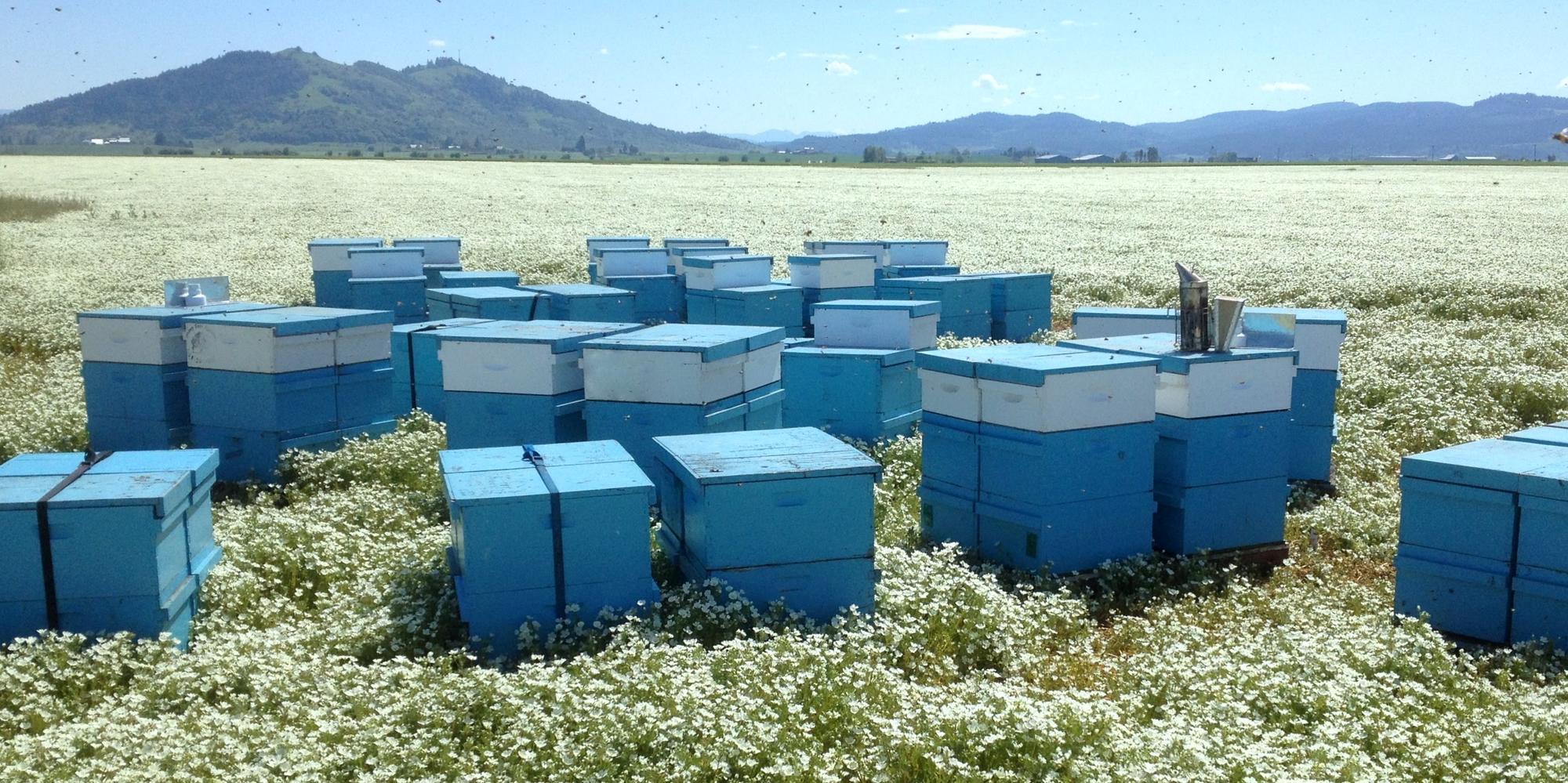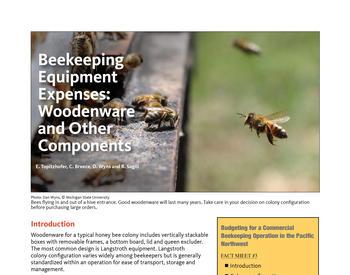Introduction
When developing a business plan for a commercial beekeeping operation, a beekeeper must plan for honey production. Even if other income sources, such as pollination or nucleus/package/queen sales, are expected to be the primary revenue stream, honey bees almost always make honey in the Pacific Northwest. The amount of honey will vary from year to year, but a plan for processing and selling honey is essential.
Facilities
A beekeeping operation requires a warehouse or base facility for equipment assembly, storage and other operations. The facility must be secure, weatherproof and bee-proof. Bees are not stored in the facility and they must be prevented from entering it. Honey bees will collect unprotected honey and cause chaos if buildings are not completely sealed. A typical warehouse facility for a beekeeping operation has an employee break room, restroom, office space, woodworking area, chemical storage and equipment storage. Warehouse space used for building and repairing woodenware should be designed to prevent sawdust and other debris from contaminating honey or stored equipment. The cost of building a warehouse varies considerably (refer to the “Further reading” section for construction cost estimation guides).
A honey house is a building for extracting, filtering, packing and storing honey. A honey house is either incorporated into the warehouse building or is a stand-alone facility. For sanitation purposes, it must be a separate area. Honey-house costs are similar to warehouse costs, but have additional expenses. A honey house must have a warming room, extraction equipment area and packing room. The warming room heats honey supers to make honey flow easier for faster extraction. This room typically includes a heating element in the floor. Honey houses must meet food safety guidelines and are subject to inspection (refer to the “Further reading” section for licensing guidelines).
Wholesale and retail honey sales
A beekeeper should decide if the honey will be sold wholesale or retail. There are advantages and disadvantages to each (Table 1). In general, selling wholesale is simpler and requires less labor, but selling retail can yield higher profits.
Table 1. Key differences with wholesale and retail honey markets
|
Wholesale |
Retail |
|
|
Market sources |
|
|
|
Proximity to market sources |
Proximity doesn’t matter |
Close proximity required |
|
Labor costs (e.g. advertising, customer service) |
Low |
High |
|
Operational equipment costs |
High |
Higher* |
|
Product purchase price** |
Low |
High |
*Requires additional equipment purchases
**Refer to Revenue Sources for a Commercial Beekeeping Operation in the Pacific Northwest
(PNW 742) for details on historic honey prices.
Wholesale honey is generally sold in 55-gallon barrels, which hold about 640–650 pounds of honey. Specialized equipment for wholesale honey includes a scale (such as a cattle scale or floor scale), lifter, heater, forklift and truck for barrels (Table 2, page 3).
For retail honey sales, there is further involvement in packing and marketing. Retail honey requires a separate packing room for bottling, labeling and packing honey for shipment. A packing room houses specialized equipment, such as bottling tanks, filter systems, barrel heaters, labelers, honey buckets or jars (Table 2). Automated equipment is available at every stage of the process.
Table 2. Purchase cost of handling equipment for honey processing
|
Cost range |
|
|
Wholesale honey |
|
|
Barrel hand truck |
$430–$690 |
|
Barrel lifter |
$800–$4,809 |
|
Barrel scale |
$850–$2,500 |
|
Retail honey |
|
|
Bottling tank |
$800–$7,000 |
|
Barrel heaters |
$153–$800 |
*Sources: Information gathered from beekeepers, Betterbee (Greenwich, New York), Cook & Beals Inc. (Loup City, Nebraska), Dadant & Sons Inc. (Hamilton, Illinois), Mann Lake Ltd. (Hackensack, Minnesota) and Maxant Industries (Ayer, Massachusetts).
Honey extraction and wax processing equipment
Operational equipment in the honey house includes honey-extraction equipment, wax-processing equipment, a hot-water system for heating tanks and warming room, pumps, and equipment for moving and storing honey. This equipment is either purchased as a package or in individual pieces. Equipment package prices for extraction lines range from $25,995 to $115,426, according to equipment manufacturers from Nebraska, Utah and New York. Figures in the “Supplemental material” section provide an overview of typical extraction line equipment prices (individually purchased) with two different wax-processing systems.
Table 3. Purchase cost of honey extraction equipment
|
Cost range |
|
|
Extraction equipment bulk package |
$25,995–$115,426 |
|
Auger (spinner option*) |
$4,809–$5,285 |
|
Auger (slurry option*) |
$4,185–$7,904 |
|
Barrel, 55-gallon |
$20–$50 |
|
Bulk equipment package |
$25,995–$115,426 |
|
Cappings spinner |
$1,700–$4,500 |
|
Deboxer |
$4,809–$5,497 |
|
Extractor, auto-load |
Not sold separately** |
|
Extractor, radial |
$4,200–$6,995 |
|
Heat exchanger |
$4,250–$11,325 |
|
Holding tank |
$1,500–$2,000 |
|
Honey sump |
$944–$3,000 |
|
Pump, gear (2-inch) |
$1,600–$5,850 |
|
Pump, high-output (3-inch) |
$3,083–$9,700 |
|
Settling tank |
$3,000–$7,000 |
|
Uncapper |
$2,595–$22,805 |
|
Wax melter |
$4,795–$9,420 |
|
Wax separator |
$9,995–$17,450 |
|
Wax spinner |
$5,000–$10,643 |
Further reading
Facility construction cost estimation guides
Oregon Department of Revenue. 2009. Cost Factors for Farm Buildings. oregon.gov/DOR/forms/FormsPubs/303-417.pdf
Pray, R. (Ed.). 2019. 2019 National Construction Estimator (67th ed.). Carlsbad, CA, Craftsman Book Company: 672 pp.
Honey labeling
Office of Foods and Veterinary Medicine, Center for Food Safety and Applied Nutrition. March 2018. Guidance for Industry: Proper Labeling of Honey and Honey Products. Docket No. FDA-2006-P-0207. www.fda.gov/regulatory-information/search-fda-guidance-documents/guidance-industry-proper-labeling-honey-and-honey-products
Licensing guidelines
Idaho
Idaho State Department of Agriculture. Warehouses. agri.idaho.gov/main/about/about-isda/ag-inspections/warehouse-control-program/warehouses/
Idaho State Department of Agriculture. ISDA licenses, registrations and certificates. agri.idaho.gov/main/licenses/
Oregon
Oregon Department of Agriculture. Food processing and warehouse licensing. https://www.oregon.gov/ODA/programs/FoodSafety/FSLicensing/Pages/ProcessingWarehouse.aspx
Washington
Barrentine, P., C. Donovan and F. Berman. 2010. Selling honey. WSDA Handbook for Small and Direct Marketing Farms (6th ed., pp. 83–84).
Washington State Department of Agriculture. Food storage warehouses. agr.wa.gov/departments/food-safety/food-safety/food-storage-warehouses
Beekeeping business plan guides
Daily, S., S. Jacobson, S. Kohler, and J. Buchhelt. 2003. Beekeeping Business Plan Workbook.
Mussen, E. 1994. University of California, Division of Agriculture and Natural Resources. Starting a Small Beekeeping Operation. sfp.ucdavis.edu/pubs/SFNews/archives/94032/
Payne, S. Bee Culture. 2016. Strategic Business Planning. beeculture.com/strategic-business-planning/
Providence of British Columbia, Minister of Agriculture, Fisheries and Food. Preparing a Business Plan: a Guide for Agricultural Producers, beekeeper example. https://www2.gov.bc.ca/gov/content/industry/agriculture-seafood/animals-and-crops/animal-production/bees
Sanford, M. University of Florida, Florida Cooperative Extension Service. December 1992. A Study in Profitability for a Mid-Sized Beekeeping Operation. Fact Sheet No. RF-AA089. ufdcimages.uflib.ufl.edu/UF/00/07/71/22/00001/AA08900.PDF
References
Oregon Department of Revenue. 2009. Cost Factors for Farm Buildings. oregon.gov/DOR/forms/FormsPubs/303-417.pdf
Pray R. (Ed.). 2019. 2019 National Construction Estimator (67th ed.). Carlsbad, California, Craftsman Book Company: 672 pp.
Townsend, E. D. 1923. End-of-season problems: more about honey marketing, rendering wax from the cappings. Gleanings in Bee Culture, 51(9): 590–591.
Tips for beginning or growing beekeeping operations:
- Infrastructure costs may be the highest expenditures for a beekeeping operation. A beginning beekeeper may be able to use a small shed, garage or storage container for storage and workshop needs. Another option is to lease space for storage until long-term facilities are acquired.
- Beekeepers can reduce the amount of facility space and capital investment if they contract another beekeeper to extract their honey. This typically involves a beekeeper transporting harvested honey supers to the hired beekeeper’s honey house. The hired beekeeper will extract the honey and charge the client beekeeper at a rate per pound or per super of extracted honey. Arrangements vary, but it is common for the hired beekeeper to keep the wax byproduct from the extraction process.
Project supported by National Institute of Food and Agriculture Smith Lever Special Needs Competitive Grants Program (Award# 2018-41210-28702).
About this series
In this series, Budgeting for a Commercial Beekeeping Operation in the Pacific Northwest, we describe potential revenue streams and expenditures associated with a commercial beekeeping operation. This publication does not discuss depreciation, interest, taxes, insurance costs or enterprise budgets. Refer to the “Further reading” section for detailed beekeeping business plan guides.
Included in this series:
- Fact Sheet 1: Revenue Sources for a Commercial Beekeeping Operation in the Pacific Northwest
- Fact Sheet 2: Operational Equipment Expenses for a Commercial Beekeeping Operation in the Pacific Northwest
- Fact Sheet 3: Beekeeping Equipment Expenses: Woodenware and Other Components
- Fact Sheet 4: Honey Bee Colony Maintenance Expenses: Supplemental Feed, Requeening and Medication
This publication will be made available in an accessible alternative format upon request. Please contact [email protected] or 1-800-561-6719. © 2020 Oregon State University. Extension work is a cooperative program of Oregon State University, the U.S. Department of Agriculture, and Oregon counties. Oregon State University Extension Service offers educational programs, activities, and materials without discrimination on the basis of race, color, national origin, religion, sex, gender identity (including gender expression), sexual orientation, disability, age, marital status, familial/parental status, income derived from a public assistance program, political beliefs, genetic information, veteran’s status, reprisal or retaliation for prior civil rights activity. (Not all prohibited bases apply to all programs.) Oregon State University Extension Service is an AA/EOE/Veterans/Disabled.
Published May 2020
© 2020 Oregon State University.








